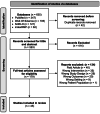Adherence to Antihypertensive Therapy and Its Determinants: A Systematic Review
- PMID: 38826951
- PMCID: PMC11144025
- DOI: 10.7759/cureus.59532
Adherence to Antihypertensive Therapy and Its Determinants: A Systematic Review
Abstract
Hypertension is a globally prevalent condition, and low adherence to antihypertensive therapy is considered one of the main causes of poor blood pressure (BP) control. Non-adherence to antihypertensive treatment is a complex issue that can arise from various factors; however, gaining an understanding of this provides key targets for intervention strategies. This study aimed to provide an overview of the current status and recent developments regarding our understanding of the determinants of patients' adherence to antihypertensives. A systematic review was performed using the electronic databases MEDLINE/PubMed, Web of Science, Scientific Electronic Library Online (SciELO), and "Índex das Revistas Médicas Portuguesas", which included studies published between 2017 and 2021 following the PICOS model: (P) Adult patients with the diagnosis of primary hypertension, using at least one antihypertensive agent; (I) all interventions on both pharmacological and non-pharmacological level; (C) patient's adherence against their non-adherence; (O) changes in adherence to the therapeutic plan; and (S) any study design (except review articles) written in English, French, Spanish or Portuguese. Articles were reviewed by two researchers and their quality was assessed. Subsequently, determinants were classified according to their consistent or inconsistent association with adherence or non-adherence. Only 45 of the 635 reports identified met the inclusion criteria. Adherence was consistently associated with patient satisfaction with communication, patient-provider relationship, their treatment, and use of eHealth and mHealth strategies; a patient's mental and physical health, including depression, cognitive impairment, frailty, and disability, previous hospitalization, occurrence of vital events; drug treatment type and appearance; and unwillingness due to health literacy, self-efficacy, and both implicit and explicit attitudes towards treatment. There were discrepancies regarding the association of other factors to adherence, but these inconsistent factors should also be taken into account. In conclusion, the barriers to adherence are varied and often interconnected between socioeconomic, patient, therapy, condition, and healthcare system levels. Healthcare teams should invest in studying patients' non-adherence motives and tailoring interventions to individual levels, by using a multifaceted approach to assess adherence. Further research is needed to analyze the impact of implicit attitudes, the use of new technological approaches, and the influence of factors that are inconsistently associated with non-adherence, to understand their potential in implementing adherence strategies.
Keywords: antihypertensive agents; antihypertensive therapy; hypertension; medication adherence strategies; mobile apps (mhealth); preventive health; primary health care; telemedical technology.
Copyright © 2024, Ferreira et al.
Conflict of interest statement
The authors have declared that no competing interests exist.
Figures
References
-
- World Health Organization. Cardiovascular diseases (CVDs) [ Dec; 2021 ]. 2021. https://www.who.int/news-room/fact-sheets/detail/cardiovascular-diseases... https://www.who.int/news-room/fact-sheets/detail/cardiovascular-diseases...
-
- OECD. Health at a glance 2021: OECD indicators. [ Dec; 2021 ]. 2021. https://www.oecd-ilibrary.org/social-issues-migration-health/health-at-a... https://www.oecd-ilibrary.org/social-issues-migration-health/health-at-a...
-
- Trends in life expectancy in EU and other OECD countries: why are improvements slowing? Raleigh V. https://www.oecd-ilibrary.org/social-issues-migration-health/trends-in-l... OECD Health Work Pap. 2019;108:24–26.
-
- Instituto Nacional de Estatística. National Statistics Institute (site in Portuguese) Estatísticas da Saúde. [ Dec; 2021 ]. Estatísticas da Saúde. https://www.ine.pt/ngt_server/attachfileu.jsp?look_parentBoui=492336067&... https://www.ine.pt/ngt_server/attachfileu.jsp?look_parentBoui=492336067&...
-
- Directorate-General for Health. National program for cerebrovascular diseases (site in Portuguese) Lisboa: DGS. [ Dec; 2021 ]. 2017. https://comum.rcaap.pt/handle/10400.26/21114 https://comum.rcaap.pt/handle/10400.26/21114
Publication types
LinkOut - more resources
Full Text Sources
Miscellaneous

